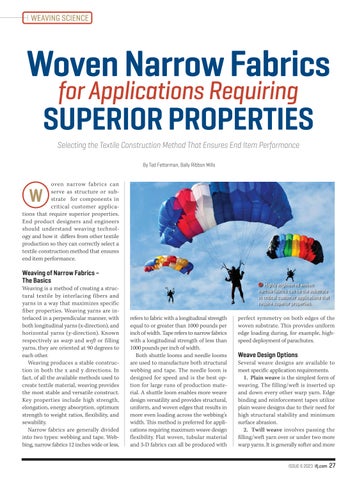WEAVING SCIENCE
Woven Narrow Fabrics for Applications Requiring
SUPERIOR PROPERTIES Selecting the Textile Construction Method That Ensures End Item Performance By Ted Fetterman, Bally Ribbon Mills
oven narrow fabrics can serve as structure or substrate for components in critical customer applications that require superior properties. End product designers and engineers should understand weaving technology and how it differs from other textile production so they can correctly select a textile construction method that ensures end item performance.
W
Weaving of Narrow Fabrics – The Basics Weaving is a method of creating a structural textile by interlacing fibers and yarns in a way that maximizes specific fiber properties. Weaving yarns are interlaced in a perpendicular manner, with both longitudinal yarns (x-direction), and horizontal yarns (y-direction). Known respectively as warp and weft or filling yarns, they are oriented at 90 degrees to each other. Weaving produces a stable construction in both the x and y directions. In fact, of all the available methods used to create textile material, weaving provides the most stable and versatile construct. Key properties include high strength, elongation, energy absorption, optimum strength to weight ratios, flexibility, and sewability. Narrow fabrics are generally divided into two types: webbing and tape. Webbing, narrow fabrics 12 inches wide or less,
Highly engineered woven narrow fabrics can be the substrate in critical customer applications that require superior properties.
refers to fabric with a longitudinal strength equal to or greater than 1000 pounds per inch of width. Tape refers to narrow fabrics with a longitudinal strength of less than 1000 pounds per inch of width. Both shuttle looms and needle looms are used to manufacture both structural webbing and tape. The needle loom is designed for speed and is the best option for large runs of production material. A shuttle loom enables more weave design versatility and provides structural, uniform, and woven edges that results in more even loading across the webbing’s width. This method is preferred for applications requiring maximum weave design flexibility. Flat woven, tubular material and 3-D fabrics can all be produced with
perfect symmetry on both edges of the woven substrate. This provides uniform edge loading during, for example, highspeed deployment of parachutes.
Weave Design Options Several weave designs are available to meet specific application requirements. 1. Plain weave is the simplest form of weaving. The filling/weft is inserted up and down every other warp yarn. Edge binding and reinforcement tapes utilize plain weave designs due to their need for high structural stability and minimum surface abrasion. 2. Twill weave involves passing the filling/weft yarn over or under two more warp yarns. It is generally softer and more ISSUE 6 2023 ifj.com 27










